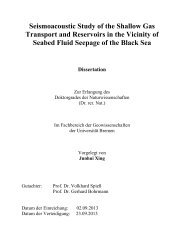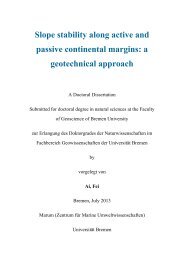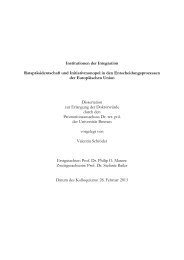��������������������������������������������������������� � Table�8.A.3:� Compiled� 14 C� dates� determined� on� cold�water� coral� fragments� (Lp,� Lophelia� pertusa;� Mo,� Madrepora� oculata)� collected� in� the� Mediterranean� Sea� comprising� the� last� 50� kyrs.� In� order� to� be� comparable,� all� 14 C� raw� ages� were� re�calibrated� by� using� the� Marine09� calibration� curve� [Reimer� et� al.,� 2009]�of�the�CA<strong>LIB</strong>�6.0�software�[Stuiver�and�Reimer,�1993]�assuming�a�reservoir�effect�of�~400�years�[Siani� et�al.,�2001],�and�are�reported�as�cal.�years�BP.�Abbreviations:�SML���Santa�Maria�di�Leuca;�MCP���Melilla� Coral�Province.� 2��range�� Median� probability� Cal.�Age� age� Sample�ID� Location� Species� [yrs�BP,�P=�AD�1950] [year�BP]� Alboran�Sea�(AS)� �� �� � � �� �� ��� 14 C�age�� Reference� GeoB�13727#1_A� MCP� Lp� 285 � 406� 339 695 ± 15� <strong>Fink</strong>�et�al.�[submitted]� GeoB�13727#2_A� MCP� Mo� 2,301 � 2,439� 2,351 2,670 ± 20� <strong>Fink</strong>�et�al.�[submitted]� GeoB�13730�1_6� MCP� Lp� 2,441 � 2,681� 2,563 2,805 ± 25� <strong>Fink</strong>�et�al.�[submitted]� GeoB�13728�1_A� MCP� Mo� 2,526 � 2,708� 2,642 2,855 ± 15� <strong>Fink</strong>�et�al.�[submitted]� GeoB�13728�1_B� MCP� Lp� 2,613 � 2,627� 2,698 2,900 ± 15� <strong>Fink</strong>�et�al.�[submitted]� GeoB�13728�2_2� MCP� Lp� 2,831 � 3,002� 2,913 3,135 ± 20� <strong>Fink</strong>�et�al.�[submitted]� GeoB�13722�3_A� MCP� Mo� 2,934 � 3,114� 3,018 3,210 ± 15� <strong>Fink</strong>�et�al.�[submitted]� GeoB�13722�3_C� MCP� Mo� 3,388 � 3,546� 3,463 3,575 ± 20� <strong>Fink</strong>�et�al.�[submitted]� GeoB�13735�1_A� MCP� Mo� 3,687 � 3,84� 3,770 3,820 ± 15� <strong>Fink</strong>�et�al.�[submitted]� GeoB�13723�1_A� MCP� Mo� 4,693 � 4,836� 4,790 4,560 ± 20� <strong>Fink</strong>�et�al.�[submitted]� GeoB�13725�2_A� MCP� Mo� 5,072 � 5,275� 5,201 4,870 ± 15� <strong>Fink</strong>�et�al.�[submitted]� GeoB�13723�1_B� MCP� Mo� 5,312 � 5,459� 5,390 5,045 ± 20� <strong>Fink</strong>�et�al.�[submitted]� GeoB�13729�1_2.5� MCP� Lp� 9,660 � 9,953� 9,810 9,085 ± 30� <strong>Fink</strong>�et�al.�[submitted]� GeoB�13729�1_49� MCP� Lp� 10,129 � 10,228� 10,181 9,330 ± 25� <strong>Fink</strong>�et�al.�[submitted]� GeoB�13730�1_102� MCP� Lp� 10,502 � 10,605� 10,556 9,700 ± 25� <strong>Fink</strong>�et�al.�[submitted]� GeoB�13729�1_140� MCP� Lp� 10,504 � 10,611� 10,559 9,705 ± 25� <strong>Fink</strong>�et�al.�[submitted]� GeoB�13730�1_194� MCP� Lp� 10,569 � 10,769� 10,652 9,810 ± 25� <strong>Fink</strong>�et�al.�[submitted]� GeoB�13729�1_315� MCP� Lp� 10,711 � 11,068� 10,889 9,935 ± 30� <strong>Fink</strong>�et�al.�[submitted]� GeoB�13729�1_375� MCP� Lp� 11,155 � 11,255� 11,206 10,225 ± 30� <strong>Fink</strong>�et�al.�[submitted]� GeoB�13730�1_298� MCP� Lp� 11,163 � 11,251� 11,208 10,230 ± 25� <strong>Fink</strong>�et�al.�[submitted]� GeoB�13728�2_191� MCP� Lp� 12,707 � 13,074� 12,874 11,415 ± 30� <strong>Fink</strong>�et�al.�[submitted]� GeoB�13737#2_A� MCP� Lp� 12,821 � 13,128� 13,005 11,515 ± 30� <strong>Fink</strong>�et�al.�[submitted]� GeoB�13728�2_295� MCP� Lp� 13,108 � 13,285� 13,194 11,700 ± 30� <strong>Fink</strong>�et�al.�[submitted]� GeoB�13730�1_427� MCP� Lp� 13,176 � 13,393� 13,291 11,825 ± 30� <strong>Fink</strong>�et�al.�[submitted]� GeoB�13737#1_A� MCP� Lp� 13,327 � 13,622� 13,452 12,025 ± 35� <strong>Fink</strong>�et�al.�[submitted]� � � � � � � � � Strait�of�Sicily�(SoS)� �� �� � � �� �� � �� �� �� MEDCOR�25� �� Lp� 81 � 433� 271 628 ± 68� Angeletti�and�Taviani� [2011]� � � � � � � � � � � Eastern�Mediterranean�Sea�(EMS)�� �� � �� �� �� �� �� �� GECO�77M� SE�Rhodes� Mo� 11,741 � 12,268� 12,019 10,67 ± 60� Taviani�et�al.�[2011]� GECO�85L� SE�Rhodes� Lp� 12,173 � 12,577� 12,379 10,87 ± 60� Taviani�et�al.�[2011]� GeoB�11185�1_15.5� SML� Lp� 1,672 � 1,910� 1,786 2,190 ± 45� <strong>Fink</strong>�et�al.�[2012]� GeoB�11186�1_9� SML� Lp� 2,580 � 2,846� 2,725 2,945 ± 50� <strong>Fink</strong>�et�al.�[2012]� COR2�101C� SML� Mo� 2,695 � 2,825� 2,747 2,975 ± 30� Malinverno�et�al.�[2010] GeoB�11185�1_27� SML� Lp� 3,715 � 4,024� 3,877 3,900 ± 50� <strong>Fink</strong>�et�al.�[2012]� GeoB�11185�1_40.5� SML� Lp� 4,641 � 5,063� 4,871 4,640 ± 70� <strong>Fink</strong>�et�al.�[2012]� GeoB�11186�1_50� SML� Mo� 5,318 � 5,586� 5,484 5,120 ± 60� <strong>Fink</strong>�et�al.�[2012]� GeoB�11186�1_30� SML� Mo� 5,382 � 5,642� 5,520 5,160 ± 60� <strong>Fink</strong>�et�al.�[2012]� GeoB�11186�1_70� SML� Mo� 5,756 � 6,099� 5,929 5,540 ± 60� <strong>Fink</strong>�et�al.�[2012]� GeoB�11186�1_110� SML� Lp� 11,190 � 11,743� 11,433 10,370 ± 80� <strong>Fink</strong>�et�al.�[2012]� GeoB�11186�1_101.5� SML� Lp� 11,215 � 11,756� 11,489 10,400 ± 80� <strong>Fink</strong>�et�al.�[2012]� GeoB�11186�1_135� SML� Lp� 11,626 � 12,327� 11,956 10,640 ± 80� <strong>Fink</strong>�et�al.�[2012]� GeoB�11185�1_70� SML� Lp� 12,882 � 13,339� 13,148 11,670 ± 100� <strong>Fink</strong>�et�al.�[2012]�� � � �
� ����������������������������������������������������� 9 Scleractinian�cold�water�corals�in�the�Gulf�of�Cádiz���First�clues�about�their� spatial�and�temporal�distribution�� �����������������������������������<strong>Hiske</strong>�G.�<strong>Fink</strong>������������������������������������������� ���������������������������������������������������� � 1MARUM���Center�for�Marine�Environmental�Sciences,�University�of�<strong>Bremen</strong>,�Leobenerstrasse,�28359�<strong>Bremen</strong>,�Germany� 2Department�of�Marine�Geology,�Royal�Netherlands�Institute�for�Sea�Research�(NIOZ),�Landsdiep�4,�1797�SZ�’t�Horntje� (Texel),�The�Netherlands� 3Department�of�Geology,�Environmental�Research�Institute,�University�College�Cork,�Cork,�Ireland� 4Department�of�Geosciences,�University�of�Catania,�Corso�Italia�55,�95129�Catania,�Italy� 5ISMAR�CNR,�Via�Gobetti�101,�40129�Bologna,�Italy� 6GeoZentrum�Nordbayern,�Paläoumwelt,�University�of�Erlangen�Nuremberg,�Loewenichstrasse�28,�91054�Erlangen,� Germany� � �������������Deep�Sea�Research�I:�Oceanographic�Research�Papers����������������������������� ������������������������������� � This�paper�presents�the�first�compilation�of�information�on�the�spatial�distribution�of� scleractinian� cold�water� corals� in� the� Gulf� of� Cádiz� based� on� literature� research� and� own� observations� (video� footage,� sediment� samples).� Scleractinian� cold�water� corals� are� widely� distributed� along� the� Spanish� and� Moroccan� margins� in� the� Gulf� of� Cádiz,� where� they� are� mainly� associated� with� mud� volcanoes,� diapiric� ridges,� steep� fault� escarpments,� and� coral� mounds.� Dendrophyllia� cornigera,� Dendrophyllia� alternata,� Eguchipsammia� cornucopia,� Madrepora�oculata�and�Lophelia�pertusa�are�the�most�abundant�reef�forming�species.�Today,� they�are�almost�solely�present�as�isolated�patches�of�fossil�coral�and�coral�rubble.�The�absence� of� living� scleractinian� corals� is� likely� related� to� a� reduced� food� supply� caused� by� low� productivity� and� diminished� tidal� effects.� In� contrast,� during� the� past� 48� kyr� scleractinian� corals� were� abundant� in� the� Gulf� of� Cádiz,� although� their� occurrence� demonstrates� no� relationship� with� main� climatic� or� oceanographic� changes.� Nevertheless,� there� exists� a� conspicuous�relationship�when�the�main�species�are�considered�separately.�Dendrophylliids� are� associated� with� periods� of� relatively� stable� and� warm� conditions.� The� occurrence� of� L.�pertusa�mainly�clusters�within�the�last�glacial�when�bottom�current�strength�in�the�Gulf�of� Cádiz� was� enhanced� and� long�term� stable� conditions� existed� in� terms� of� temperature.� Madrepora�oculata�shows�a�higher�tolerance�to�abrupt�environmental�changes.� � Keywords:������������������������������������������������������������������������������������� ��������������������������������������������������� � � ���

















